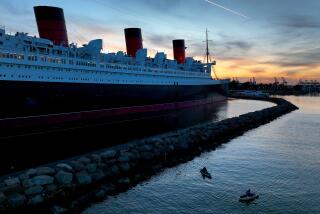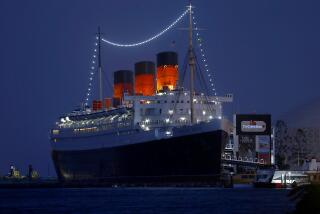World’s Most Famous Ocean Liner Sets Sails for the 21st Century
- Share via
Nobody said it was going to be easy, even for the world’s most famous ship. But Cunard’s beleaguered Queen Elizabeth 2, hit in fewer than four weeks with a couple of tough blows that would have sent a lesser vessel reeling, has survived nicely. All she needs to sail smoothly into the 21st Century is to straighten her tiara and rearrange her robes.
The dowager ocean liner, launched in 1969 by Britain’s Queen Elizabeth II, recently underwent a six-month, $160-million renovation in the Lloyd Werft Shipyards in Bremerhaven, West Germany.
Although some cosmetic work was scheduled, the primary purpose was to change from steam turbines to less-costly diesel electric engines, adding speed as well as efficiency and making the irreplaceable 67,000-ton ship capable of service well into the first quarter of the next century.
The re-engine procedure has already proved successful, according to Capt. Lawrence Portet, with the ship showing “greatly increased maneuverability; she’s much easier to handle.” Oil consumption is reduced dramatically, he says, and “normal cruising speed now is the previous top, 29.5 knots.”
Union Contract Ended
Less publicized when the ship went into dry dock last November was the termination of its British maritime union contract, allowing Cunard to reduce operating costs by hiring non-union staff and crew, which ruffled some feathers among British labor.
Then came a wash of negative publicity in early May from the ship’s first sailing after its refit, where some passengers complained of unfinished staterooms, erratic air conditioning and leaking water pipes.
The grumbling aboard the charismatic vessel made newspaper headlines and TV and radio newscasts around the world, despite the fact that such problems are commonplace on shakedown voyages.
Hindsight suggests that Cunard may have been overly optimistic in setting out with a shipload of full-fare passengers, a not-quite-finished refit and a goodly sprinkling of brand-new waiters and stewards.
Perhaps if those first passengers had been given a modest discount up front and told that work would continue on board en route to New York, it might have alleviated some of the complaints, along with the costly 40% rebate that was ultimately awarded.
No sooner were all the physical problems settled in late May, on a New York-to-Southampton crossing, than a storm that seemed to spring full-blown out of nowhere buffeted the ship for 16 hours with gale winds of up to 50 m.p.h. The winds registered Force 10 on the Beaufort scale and left in their wake smashed dishes and glassware, spilled vases and planters, broken lounge tables and even upturned grand pianos.
Worst Storm Ever
For those of us on board, the storm, with its 37-foot seas, was the most severe we could remember--longtime crew members termed it the worst they had experienced since 1971--and yet the QE2 rode it out impressively with Portet, a 41-year Cunard veteran who has spent a large part of his working life on the North Atlantic, in command.
The ship’s officers, staff and entertainers did their utmost to keep passengers safe and comfortable. Pianist Leonard Pennario went on in concert as scheduled in the waning hours of the storm, playing a Steinway grand that had been lashed to the side of the stage in the 500-seat theater, and Broadway composer Charles Strouse (“Annie,” “Bye Bye Birdie,” “Applause”) stood in for French composer Michel Legrand in an evening lounge show.
The stiff-upper-lip attitude was especially noticeable at the height of the storm in the Queens Grill, where unflappable British waiters served breakfasts of fresh-squeezed orange juice and hot bacon and eggs. And between bouts of vacuuming up spilled sugar and wetting down tablecloths to keep dishes from sliding, apologized that the full menu selection was not available that morning.
Now that both storm and shakedown have passed into history, passengers making crossings later this summer or fall--or booking Caribbean or world cruise segments this winter--will find the ship looking better than it has in a long time.
Dining Rooms Refurbished
All four dining rooms have been refurbished, with the most dramatic transformation in the transatlantic class dining room--formerly known as Tables of the World, now the Mauretania--where a soft pink-and-rose color scheme and mirror-trimmed Art Deco design have been installed, along with a huge oil painting and scale model of Cunard’s gracious pre-World War I ship, the Mauretania.
Harkening back to the elegance of that earlier day, both the Mauretania and the pretty, rose-colored Columbia restaurant have added dinner-dancing on certain evenings. The first-class Queens Grill sparkles with chic, its original black-and-white decor restored, its walls adorned with silver-framed Erte prints.
While the QE2 is the only ship that still maintains two classes--first and transatlantic--on its crossings (but only one class on its cruises), passengers should not expect to encounter the old barriers that used to divide classes on transatlantic liners. Instead, only cabin and restaurant assignments are separated by class, with dining-room seating based on cabin category.
Inhabitants of the most expensive lodgings are assigned to the Queens Grill and the Princess Grill, while the other first-class staterooms are matched with the Columbia restaurant, and the lower-priced cabins with the Mauretania.
Other than the grill rooms and their small adjacent bars, the entire ship, from the Golden Door at Sea spa to all lounges and entertainment, is open to everyone.
Lighter Cuisine
With the introduction of fresher, lighter cuisine from executive chef Karl Winkler, the streamlined, younger-looking Queen seems to have streamlined, younger-looking passengers in mind as well. The elaborate midnight buffets have given way to smaller arrangements of light snacks around the bars and casinos for hungry night owls. Plans call for an international food bazaar on some evenings in the Mauretania, open to all passengers.
Unlike the old days, the same menu is offered in all four dining rooms, so passengers paying the least for their cabins have the same selections as those paying the most.
What advantages, then, does traveling first-class offer? In the restaurants it means one sitting instead of two, service by senior waiters, and the opportunity to request special dishes by advance order.
Tipping guidelines for the top first-class cabins suggest $5 per person a day to each waiter and steward. That’s in comparison to the transatlantic class’s $3.
The QE2’s shopping arcade has been growing steadily, first with the addition of a pint-size branch of Harrods several years ago, and now with a glittering row of famous-name boutiques from Dunhill to Dior, Gucci to Burberry, Louis Vuitton to H. Stern. One great idea: a new tailor shop where passengers can rent or buy a tuxedo and have it altered to fit (rental is $40 a night).
Eight new penthouse suites have been added to the signal deck high atop the ship, and top-priced suites now include color TV, VCRs and electric beds that passengers can raise and lower by pushing a bedside button.
New Games Added
The former Double Down Room has been glamorized with a curved double staircase and sound and light equipment; it’s now the Grand Lounge. Plus, the popular IBM computer center has been enlarged. New pastimes include an electronic golf course simulator, a multitiered deck pool with Jacuzzis, a youth club with video games and a lounge/piano bar called the Yacht Club.
Regular fares for the five-day crossings this summer and fall start as low as $1,250 per person double occupancy, for a November sailing in transatlantic class, and $2,295 in first-class, including economy return air fare on British Airways. A surcharge of $775 or $825, depending on the date, adds a British Airways Concorde flight aboard a special QE2 charter.
Cunard has also just announced a QE2 standby fare to Europe for $799 one way or $999 with return air fare ($1,099 from West Coast cities). To qualify, passengers (or their travel agent) must send a written request and $100 deposit to Cunard, 555 Fifth Ave., New York 10017. They will be notified three weeks in advance of their sailing date.
More to Read
Sign up for The Wild
We’ll help you find the best places to hike, bike and run, as well as the perfect silent spots for meditation and yoga.
You may occasionally receive promotional content from the Los Angeles Times.






